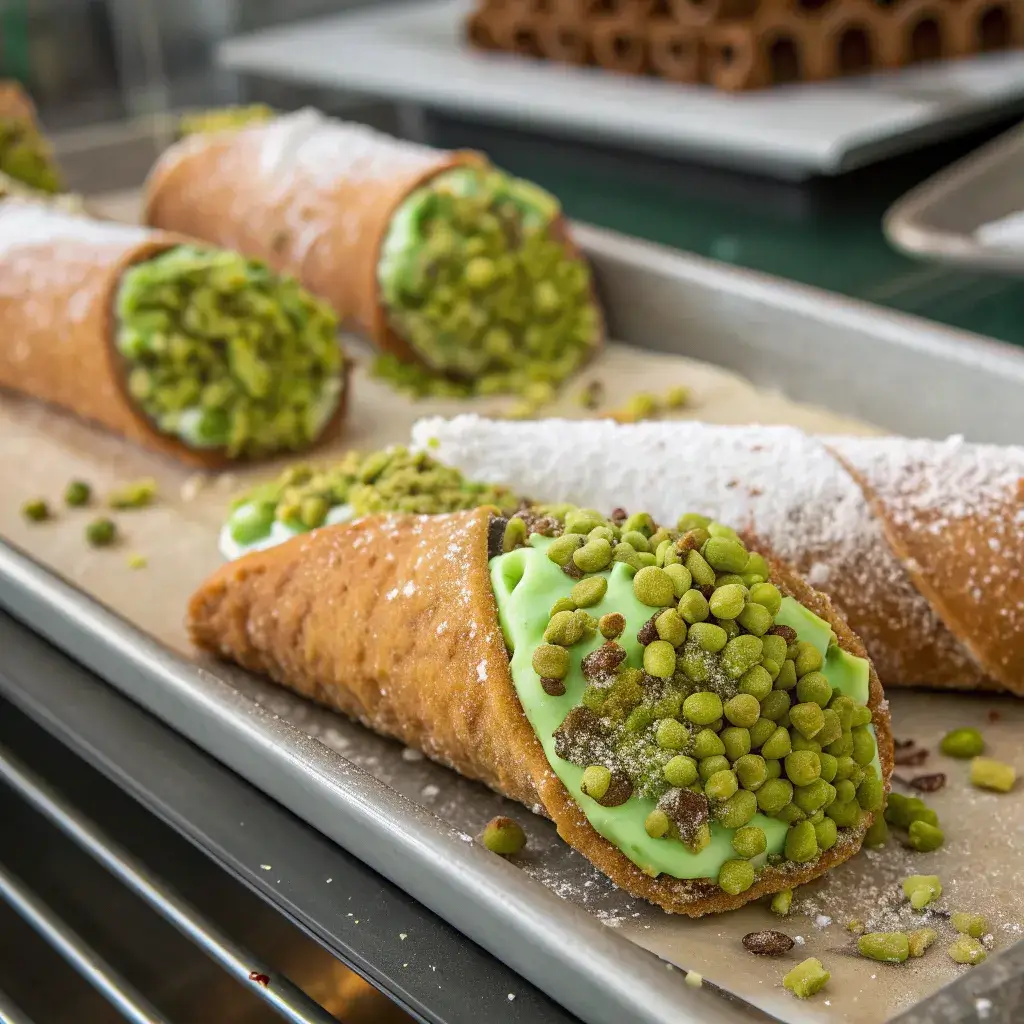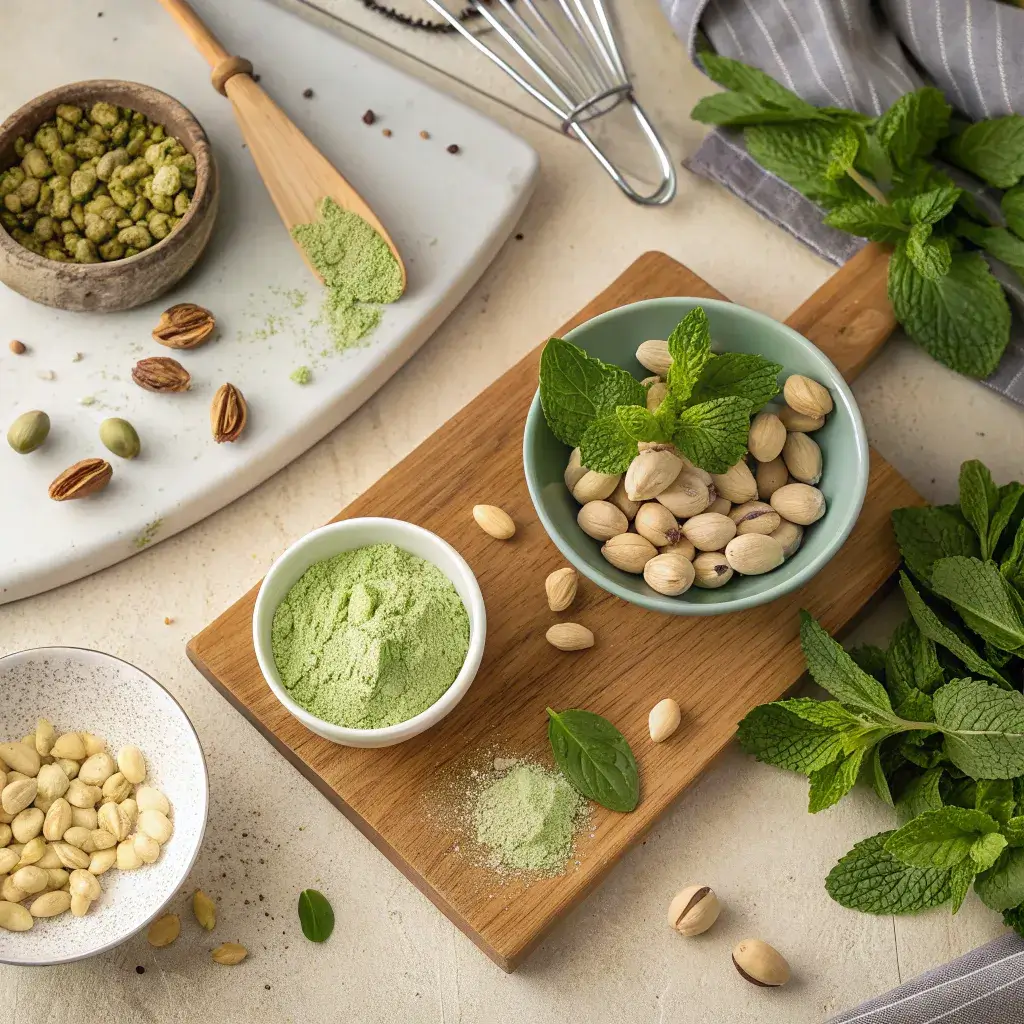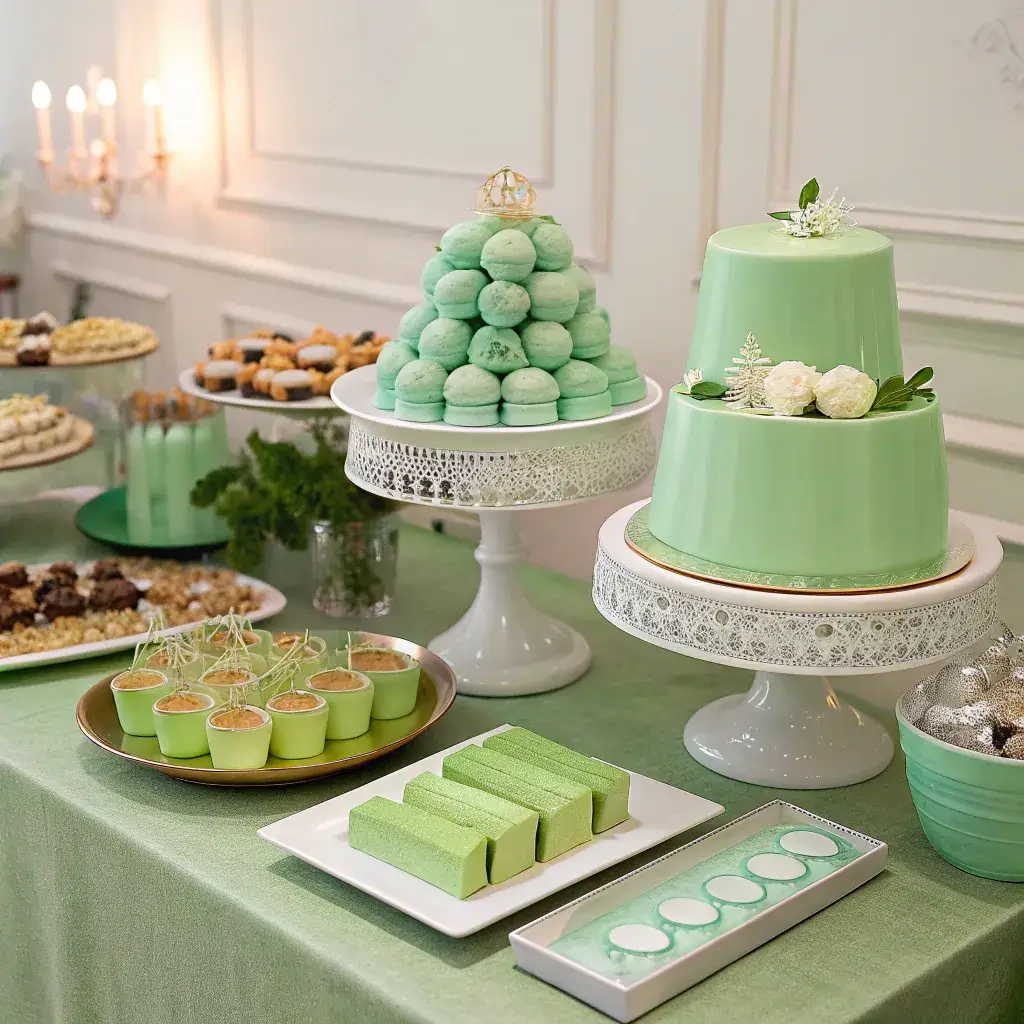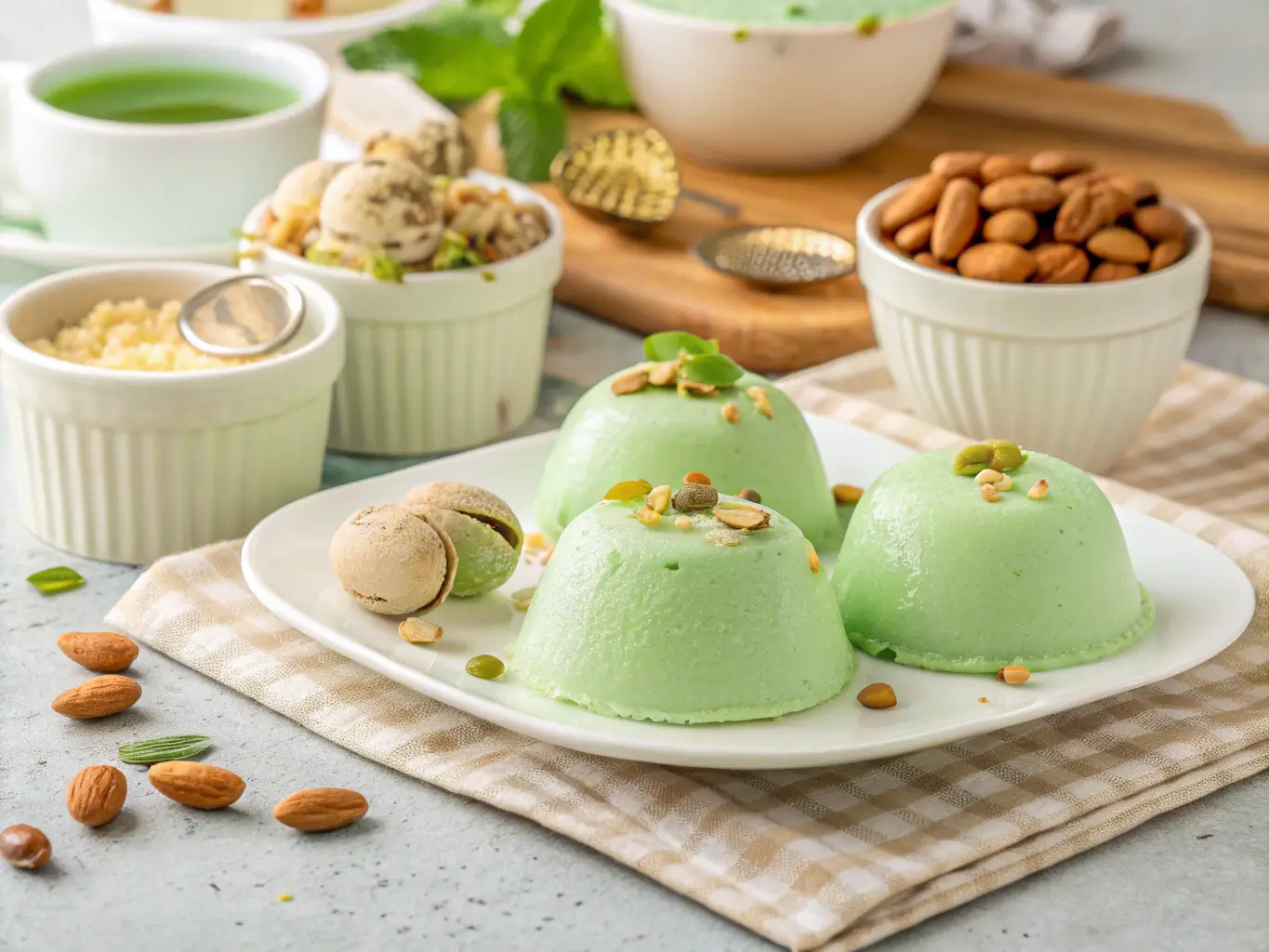Mint green color in Italian desserts is more than just decoration, it’s a symbol of freshness, elegance, and tradition. Seen in classics like Sicilian cassata and pistachio gelato, this pastel hue often comes from natural ingredients such as pistachios, almonds, or candied fruits. It pairs beautifully with white and cream tones, creating a refined look that’s perfect for weddings, festivals, and special occasions.
In this guide, we’ll explore its Italian name, the famous sweets that feature it, and how to create the shade naturally or with food coloring.
Why Mint Green is Iconic in Italian Sweets
Symbolism and Aesthetic Appeal
In Italian pastry-making, presentation is just as important as flavor. The mint green color in Italian desserts represents freshness, lightness, and elegance. It’s often chosen for festive occasions such as spring weddings, Easter celebrations, and refined afternoon teas. The soft pastel tone pairs beautifully with white icing, cream layers, and delicate sugar decorations, giving desserts a luxurious yet approachable charm.
Connection to Natural Ingredients
In Italian desserts, the soft mint-green hue often comes from natural sources rather than artificial dyes. Ground pistachios, young green almonds, and candied citrus peels can all lend gentle shades of green. When blended with sugar, cream, or icing, these ingredients create the signature mint color. This natural origin doesn’t just enhance visual appeal, it also reflects quality and freshness, two hallmarks of traditional Italian baking.
Natural Green Color Sources in Italian Desserts
- Ground pistachios
- Green almonds
- Candied citrus peels
- Matcha (modern variations)
- Spinach purée (for subtle natural coloring)
What Is Mint Green Color Called in Italy?
Italian Names for Mint Green in Culinary Contexts
In Italy, mint green color in desserts is most often described as “verde menta” or “verde pastello” when referring to soft, pastel shades in culinary use. In pastry shops, especially in regions like Sicily and Lombardy, you might also hear “verde pistacchio” if the hue comes from natural pistachios. Each term has its nuance:
- Verde menta → freshness and vibrancy
- Verde pistacchio → flavor and authenticity
- Verde pastello → elegance and refinement
Regional Variations in Color Naming Across Italy
Italian dessert culture is deeply regional, and the mint green color may be described differently depending on the area.
- Northern Italy: High-end patisseries, particularly in Lombardy and Piedmont, sometimes use French-inspired terms like vert menthe.
- Southern Italy (Sicily, Calabria): Color descriptions often reference the ingredient source pistachio, almond, or candied melon, linking flavor to hue.
No matter the terminology, this color in Italian pastries always reflects refinement, craftsmanship, and artistry.
Sicilian Desserts That Combine Green and White Layers
One of the most iconic examples of the mint green color in Italian desserts is the cassata Siciliana, a traditional sponge cake layered with sweet ricotta and decorated with jewel-like candied fruits. Its smooth marzipan or almond paste coating is often tinted a delicate mint green, creating a striking contrast against pure white icing. Another classic is pistachio cannoli, where the cream-filled pastry ends are dipped in finely chopped pistachios. The nuts lend a natural pastel hue that’s as flavorful as it is beautiful.
Classic Gelato Flavors in Mint Green
Across Italy, gelaterias proudly feature the mint green color in Italian desserts with two timeless flavors: pistachio gelato and mint gelato. Pistachio gelato gets its natural green hue from finely ground pistachios, while mint gelato often uses plant-based colorings to match its fresh flavor. Both flavors stand out in the display case, their soft green tones inviting customers to indulge in a sweet, visually stunning treat.

Iconic Italian Desserts with Mint Green Color
| Dessert | Region | Color Source | Flavor Profile |
|---|---|---|---|
| Cassata Siciliana | Sicily | Naturally tinted marzipan or almond paste | Sweet ricotta filling, candied fruits |
| Pistachio Cannoli | Sicily | Finely chopped pistachios | Crisp pastry shell, creamy pistachio-infused filling |
| Pistachio Gelato | Nationwide | Ground pistachios | Nutty, creamy, slightly sweet |
| Mint Gelato | Nationwide | Natural plant-based coloring | Cool, refreshing mint |
The Sicilian Dessert That is Green and White
Cassata Siciliana – A Heritage Dessert
Among Italian desserts, Cassata Siciliana stands out as a classic example of the elegant mint-green color. With origins tracing back to Sicily’s Arab-influenced pastry traditions, it’s made with sponge cake, sweet ricotta filling, and a coating of green almond paste. The green layer, softened into a mint hue, pairs with white icing for a visually stunning presentation, making it a centerpiece at Easter and other celebrations.
Pistachio as the Green Star Ingredient
Bronte pistachios, grown in Sicily, are renowned for their intense flavor and striking natural color. When used in cassata, pistachio cream, or other sweets, they produce the signature mint green color in Italian desserts without artificial dyes. This connection between natural ingredients and visual appeal reinforces the authenticity and artistry of traditional Italian baking.
How to Make Mint Green Color for Desserts
Natural Ingredients to Achieve the Hue
- Ground pistachios, green almonds, and candied citrus peels can produce soft green tones.
- Blend these natural sources into creams, marzipan, or icing for a delicate, authentic look.
- Fresh mint leaves can be steeped in cream or blended into syrups for both color and flavor.
- These methods provide the mint green color in Italian desserts while enhancing taste with subtle, complementary notes.
Using Food Coloring for Consistency
- For a perfectly uniform mint green color in Italian desserts, opt for gel-based or powdered food coloring.
- These mix smoothly into icing, marzipan, or fondant without altering texture.
- Many professional pastry chefs combine natural coloring with a touch of food-safe dye for a consistent pastel shade.
- This approach keeps the look close to traditional Italian presentation while ensuring visual precision.

Techniques for Decorating Italian Desserts with Mint Green
Piping, Icing, and Glazing in Pastel Shades
- Pastry chefs often showcase the mint green color in Italian desserts through intricate piping, smooth icing layers, and glossy glazes.
- Marzipan or fondant can be tinted with pistachio paste or food coloring for a soft pastel finish.
- Icing sugar mixed with green-tinted syrup creates a delicate glaze for cookies and pastries.
- Buttercream can be whipped into airy, mint-hued swirls for cakes and layered desserts.
- These decorative methods highlight both the dessert’s beauty and its traditional Italian character.
Pairing Mint Green with Complementary Colors
| Color Pairing | Best Use in Desserts | Why It Works |
|---|---|---|
| White & Cream | Background icing, cream fillings | Keeps the mint green color in Italian desserts fresh and elegant |
| Soft Pink | Marzipan flowers, frosting accents | Adds a romantic, pastel harmony |
| Gold Leaf | Festive cakes, cassata decoration | Elevates luxury and celebration feel |
| Red Candied Fruits | Sicilian cassata, holiday pastries | Creates bold contrast while enhancing festive appeal |
Italian Pastry Shops and Regions Known for Mint Green Sweets
Famous Sicilian Pastry Shops
Sicily is home to renowned bakeries where the mint green color in Italian desserts is a signature feature. In Palermo and Catania, traditional pastry shops display cassata Siciliana and pistachio-based confections in glass cases, their pastel shades drawing in locals and tourists alike. These bakeries often rely on generations-old recipes that keep the color and flavor authentic.
Mint Green Creations in Northern vs. Southern Italy
The South of Italy, particularly Sicily, is renowned for its mint-green desserts, but Northern Italy also celebrates this colorful tradition. In cities like Milan and Turin, pistachio mousse cakes, mint panna cotta, and pastel macarons showcase the mint green color in Italian desserts in a more modern, minimalist style. This regional variety highlights how the same hue can adapt to different pastry traditions across the country.
Mint Green in Modern Italian Dessert Trends
Minimalist Pastel Cakes and Gelato Displays
In contemporary pastry-making, the mint green color in Italian desserts is often used in minimalist designs. Pistachio mousse cakes, pastel gelato displays, and panna cotta cups use this gentle shade to create a clean, modern aesthetic. The soft green hue conveys sophistication while still hinting at natural ingredients like pistachios or mint leaves.
Social Media Influence on Color Choices
With the rise of Instagram and Pinterest, the mint green color in Italian desserts has become even more popular. Pastel shades photograph beautifully, and this green tone stands out without being overpowering. Many pastry chefs intentionally create desserts in mint green to appeal to online audiences, knowing the color evokes freshness, elegance, and a sense of indulgence.
Serving and Presenting Mint Green Desserts
Table Styling for Pastel-Themed Desserts
When showcasing the mint green color in Italian desserts, presentation plays a big role. Serving cassata Siciliana on white porcelain plates, displaying gelato in silver bowls, or arranging pistachio pastries on pastel trays helps the color stand out. Adding floral accents in white or blush pink further elevates the overall look.
Occasions Where Mint Green Shines
The mint green color in Italian desserts is perfect for spring weddings, Easter celebrations, and elegant afternoon teas. It pairs beautifully with seasonal flowers and light linens, creating a refined, inviting table. Whether it’s a traditional cassata or a modern pistachio mousse, the mint green hue adds a festive touch that feels timeless and sophisticated.

FAQs About Mint Green Color in Italian Desserts
What is mint green color called?
In Italy, the mint green color in desserts is often called verde menta, verde pastello, or verde pistacchio if it comes from natural pistachios. Each term can convey a different nuance, from freshness to elegance, depending on the dessert and region.
What is the Sicilian dessert that is green and white?
The most famous Sicilian dessert that’s green and white is the cassata Siciliana. It features layers of sponge cake, sweet ricotta filling, and a smooth almond paste coating tinted with the mint green color in Italian desserts, accented by white royal icing.
How to make mint green color?
You can achieve the mint green color in Italian desserts using natural ingredients like ground pistachios, green almonds, or mint leaves. For a more precise pastel shade, professional bakers often combine these with gel or powdered food coloring to keep the hue consistent.
What is the Italian dessert called?
When people refer to “the Italian dessert” with a mint green coating, they are often talking about cassata Siciliana, though pistachio gelato and other regional pastries also showcase the mint green color in Italian desserts beautifully.
Conclusion
The mint green color in Italian desserts is more than just a visual choice; it’s a connection to tradition, natural ingredients, and timeless elegance. From the almond paste coating of cassata Siciliana to the creamy swirls of pistachio gelato, this shade evokes freshness and artistry. Whether achieved naturally through pistachios and almonds or perfected with professional coloring techniques, it’s a hue that continues to inspire pastry chefs across Italy. By understanding its history, cultural significance, and decorative possibilities, you can incorporate the mint green color in Italian desserts into your own baking, creating sweets that are as beautiful as they are delicious.

